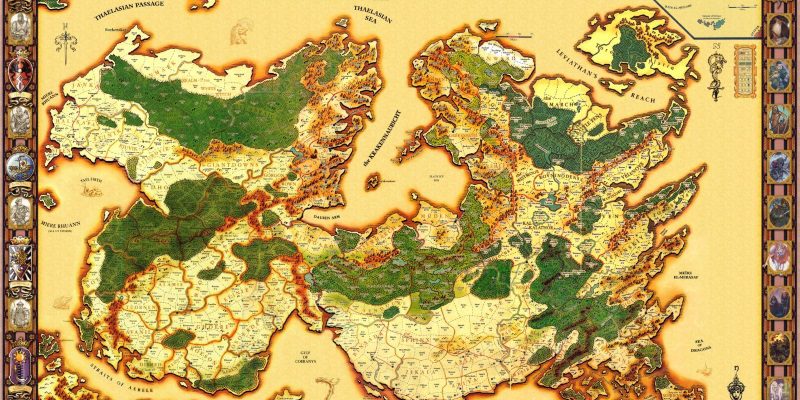Domain Rulership, Part Four

Two weeks ago, I covered domain rulership in the AD&D 2e DMG and The Castle Guide. Not too long after the latter came out, TSR released Birthright, which ignores it completely, operates on an unrelated set of assumptions, and presents rules for domains anywhere from the size of a small business or cult all the way up to an empire of many provinces. I’ve been going on about how much I love Birthright since I started this series, so you won’t be surprised by full-throated praise – but at the same time, it works a hell of a lot better with electronic aids than it does with pencil-and-paper accounting.
Part One | Part Two | Part Three | Part Four
Birthright
The setting has two core assumptions: first, that the divine right of kings to rule is real and magical, and second, that PCs rule various things – land (both geographically and politically), temples, businesses, and wellsprings of arcane energy, starting at first level. Because divine right of kings is real, it means something to rule land even without any political sway there. The king – regent, in BR’s terminology – and the land are one; as the land prospers, so the PC can magnify the power of the bloodline. (To say nothing of the delicious ten extra hit points that regents get for ruling something. Anything.)
Each province has two core statistics: its province level and its maximum source level. Province level is a measure of population, prosperity, and importance, while source level determines how much magical energy can flow from the province for arcane spells. Grasslands and clear-cut areas have very little magical energy, while forests have more and mountains have the most. Increasing the province level causes the source limit to drop, but (maybe oddly) forbidding terrain has no stated effect on construction and population growth. This would be pretty easy to hack into the rules, I suppose, but it is especially surprising when considered alongside The Castle Guide and its obsessive application of price-gouging modifiers.
Province levels range from 0 (wilderness, up to 1,000 people) to 7 or nominally higher (100,000+ people – a reasonable approximation of the population of London in the 16th century). In addition to being a tax base unto itself, province level is also the upper bound of all law (political control), temple (spiritual influence), and guild (business influence) holdings in the province. One of BR’s basic assumptions (because it’s still Dungeons & Dragons) is that there will be multiple PCs, who probably divide up these holdings among themselves, more or less along class lines.
To explain why that’s important, I need to discuss what a Regency Point is – not, in this case, an apartment complex or movie theater. Regency Points, or RP, are a kind of mystical strength and measure of influence that a regent wields. It is one of the two core currencies of BR’s domain management rules; the other is actual currency, or Gold Bars. Just about every rulership-related task involves a d20 roll with modifiers, and RP affect the odds. Most actions also have an intrinsic RP cost. Also, and this is a very big deal, increasing the strength of your bloodline costs an ever-greater number of RP.
A regent gains RP from controlling a province, and from controlling class-appropriate holdings within a province. Higher-level provinces and holdings generate more RP. Notably, it doesn’t look evenly balanced between classes – warriors (fighters, paladins, and rangers) gain RP equal to their Law holdings, but paladins also gain RP equal to their Temple holdings, and ranger equal to their Guild holdings. Sorry, fighters! In 2e you’re a fallback option and the rules take every chance to drive that home.
This also has the weird effect of steering players toward Good-aligned domains – if you want to be the best possible warrior regent, you need to be a paladin or ranger, and to do that, you need to be Good. At least BR has Chaotic Good paladins! Another of 2e’s little design artifacts.
Thieves, though – thieves are where it’s at for soaking up those sweet, sweet RP, because trade routes. Every GB they gain from trade routes also nets them an RP, and that can get abusive in a hurry. In addition, they gain 1 RP for each level of Guild holdings and 1 RP for every 2 levels of Law holdings. Really, all that can stop them is that you can’t earn more RP than your bloodline score – which just induces you to boost your bloodline score further.
Regents receive RP and GB at the start of each domain turn (a season, or three months). Each of these turns includes:
- One random (or chosen-by-the-DM, whatever) event, to increase complexity and give the players new problems. The 2d10 table has fourteen events, plus a No Event. The resolution mechanic is somewhat complicated.
- Domain initiative, because things have to be resolved in some order of operations.
- Regency income. Calculating this is relatively simple.
- Gold Bar income from taxes, holdings, trade, or tribute extracted from other regents. Calculating this is complicated and involves an aggregation (or aggravation, YMMV) of dice rolls
- Maintenance Costs: provinces and holdings have a cost that scales more slowly than their income, but this puts a bit of a brake on having a lot of level 0 provinces or holdings. Level 0 holdings are useful as a way to annoy other regents. Also, armies and maintaining a lavish court are both ruinously expensive.
- Free Actions precede standard domain actions – some things a regent can simply enact by decree, and some classes gain a free use of a particular action once per turn. (This is immensely powerful if used well, but that “free” doesn’t get you out of RP and GB costs.)
- The three action rounds, executed in order of initiative. Also, a single action round can be split into four War Moves. An adventure (PCs still go on adventures in BR, don’t worry!) typically takes one action. There are twenty-five actions described in the main book, and I think there are a few others in later setting expansions.
- Resolve changes to loyalty and regency. This is fairly complex.
In total, this is one of the more complicated management systems out there, with a lot of numbers that can go up or down, dice to roll, and so on. On the other hand, it presents the richest landscape I have yet seen for politics and maneuvering, with many thorny choices and problems you can’t afford to ignore for too long. Without turning the system into combat-like resolution, it creates a system about as complicated as D&D combat.
I cannot overstate the usefulness of even amateur-hour electronic aids. I occasionally (okay, it’s been more than two years, but we have a toddler, so don’t act surprised) a 5e-based Birthright solo campaign for my wife, and the Excel spreadsheet that I ginned up on the fly – including die rollers to handle taxation – made things immeasurably better. I love Birthright, but its depth comes with complexity, and that complexity scales pretty sharply as your domain increases.
The list of twenty-five actions is a big part of what makes the system work. Outside of overt warfare, the whole system kind of hangs on two: Contest and Rule. With Contest, you target an enemy holding. On a success, you destroy a level 0 holding, or flip a stronger holding to Contested, causing it to yield neither RP nor GB for its owner until it is successfully Ruled. If you use Contest against an already Contested holding, you wipe that holding out, leaving its “place” within the province’s potential vacant. You can also contest a province, and conquest during a war (prior to divestiture and annexation) automatically makes the province Contested.
Rule (and its more basic form, Create Holding) let you increase the level of provinces or holdings, or shed the Contested condition. Together they form the core of a move-countermove gameplay that encourages you to strike when your enemy’s attention is elsewhere and their RP reserves are low. If they can’t spare an action to Rule the things you’ve Contested, or if they’re Contested on so many fronts that they can’t afford to Rule everything back up, you can wipe out large holdings in a single domain turn. If their RP reserves are low, they won’t be able to afford to Rule lots of things in a single action, and they won’t have much to put into the success chance bidding war.
The other major area of complexity, for which the books give only a little advice, is how to manage all of those NPC domains. It is very important to make them active and sometimes aggressive toward the PCs – otherwise you wind up with the BR campaign I ran in high school, where the PCs get to improve their own domain without external pressure, and then start getting aggressive with their fairly passive neighbors. Rather than managing the cash and RP availability of NPCs, I would recommend building a table of neighboring NPC regents, and using a few die rolls to determine how many of them spend one or more actions interfering with the PCs’ domain and holdings this turn. A 1d20 table, rolled 2dX times, where X is based on how vast the PCs’ domain has become, should be able to handle most things. I would further encourage the DM to have more powerful NPC domains gobble up lesser ones as the PCs expand, just to keep the list of candidates to something that fits on a 1d20 table.
Also, the 19 spot on that table should probably always be the nearest awnsheghlien (monstrous rulers, the big bads of the setting), and the 20 spot should always be the greatest awnsheghlien of your region. The Gorgon for Anuire, the White Witch for Rjurik, the Magian for Khinasi, and so on.
There’s almost no stronghold-building game here, because the system’s “camera” is zoomed too far out to care all that much about individual fortifications. There are, however, the Build and Fortify actions. Build lets you construct any number of things, though the game effect of these is a bit muted. Building palaces is useful, but (predictably) expensive. Fortify is the bigger deal for stronghold-building, and lets you build castles that can house garrisons (one unit per level) and protect your holdings. That is the extent of the detail around castle-building. It puts one more in mind of Edward I of England’s castle-building throughout Wales than the single-structure style we’ve seen up to this point in D&D’s history.
Spellcasters, and wizards even more so than priests, are playing an almost unrelated game. I love that these rules delve into the effects of magic on warfare and domain rulership, and I could easily get obsessed with the separate-ness of wizards – they’re chasing domain stats that no one else cares about, establishing holdings that no one else can use in any way, and figuring out maps of ley lines to route power from ancient and powerful sources to wherever they actually want to live.
Priests and wizards have battle spells – normal spells rescaled to warfare casting times and usage – and realm spells, which are larger effects to influence a province or a whole domain. The Book of Magecraft splatbook adds a huge number of arcane realm spells, and the Book of Priestcraft does the same for divine spells. Arcane realm spells require source holdings in the province from which you cast, and you can forge a ley line from that one distant super-magical mountain or forest all the way to your densely-populated capital if you need to. (It’s interesting that ley lines are engineered rather than natural occurrences in Cerilia, but there you go.) Divine casters, including druids for no reason that I could ever quite grasp, need temple holdings of a certain level, and have no cognate of the ley line.
Another oddity of BR, compared the only other kingdom-building rules we’ve seen from Companion, is that land is divided into provinces, and it is always conquered and annexed as a whole province. It would be nonsense in the setting for a war to subdivide a province, or the front line of a war to be halfway through a province at the end of a turn. Compare this to a single hex as a unit of territory, as we see in Companion and a whole lot of other D&D-based gaming. It’s openly artificial, but then the land is the source of magic in the world, so it’s not like it doesn’t fit – and it definitely makes for better gameplay than redrawing map lines all the time.
Birthright is a huge shift in thinking about domain-level play. Rulership starts at first level, rather than years into the campaign. It dives deeper into detail than most of what came before it, though I should really figure out the chronology of King Arthur Pendragon development before I go too far with assertions there. Grandeur of scope and courtly pomp and circumstance are the baseline assumption. It’s a lot to manage compared to its predecessors, but it is light and airy (or shallow, if you prefer) compared to later works – Pathfinder’s Ultimate Campaign springs to mind here, based on even the most superficial reading.
What Birthright gets in exchange for its number-crunching is an enormous amount of verisimilitude and political maneuvering that isn’t a perfect analogy for real late-medieval politics, but is remarkably good nonetheless. There are multiple arenas in which to engage an enemy – warfare, infiltrating their provinces and contesting their holdings, agitating for instability (which can wreck a previously stable tax structure in frighteningly short order), or divine and arcane magical conflict. If you’re weak in one area and strong in another, you can look for ways to redirect the conflict toward your strength, or use your strong suit to make the conflict untenable for your opponent.
What the designers also created is a surprisingly good PvP game. Birthright has a long history as a play-by-mail, email, or forum campaign, in which players are assigned a regent and thrown in with the sharks, who are also PCs. The designers seem to have had cooperative play in mind, but also had a deep understanding of how to create engaging asymmetrical PvP play. Some domains are a single, powerful province, such as Ilien, while others are sprawling and lightly inhabited. The action economy and the limits on the RP economy create a situation where David can hold off Goliath, because Goliath has other concerns, while David doesn’t need to do anything but beat this guy. I don’t know for sure, but I suspect that the designers drew a lot of inspiration from Diplomacy and Risk in setting up their approaches to conflict and the détente of the starting regional maps.
To my deep sorrow, Birthright was not a commercial success, and hasn’t seen an official update into any later edition. The online fan works are extensive, of course – that’s cult followings for you. But hey, Aebyrnis (the world of which Cerilia, Birthright’s setting, is one continent) got a mention in the 5e Dungeon Master’s Guide! It’s closer to official support than it saw between 2000 and 2014.
Next time in the Domain Rulership series, I’ll move on to D&D 3.x, and I suspect I’ll be digging through a lot more books to find stronghold-building rules. If you know offhand where I should be looking, it would be mighty kind of you to mention something in the comments, because there’s a whole mess of 3.x to dig through for rules that might not be there.



